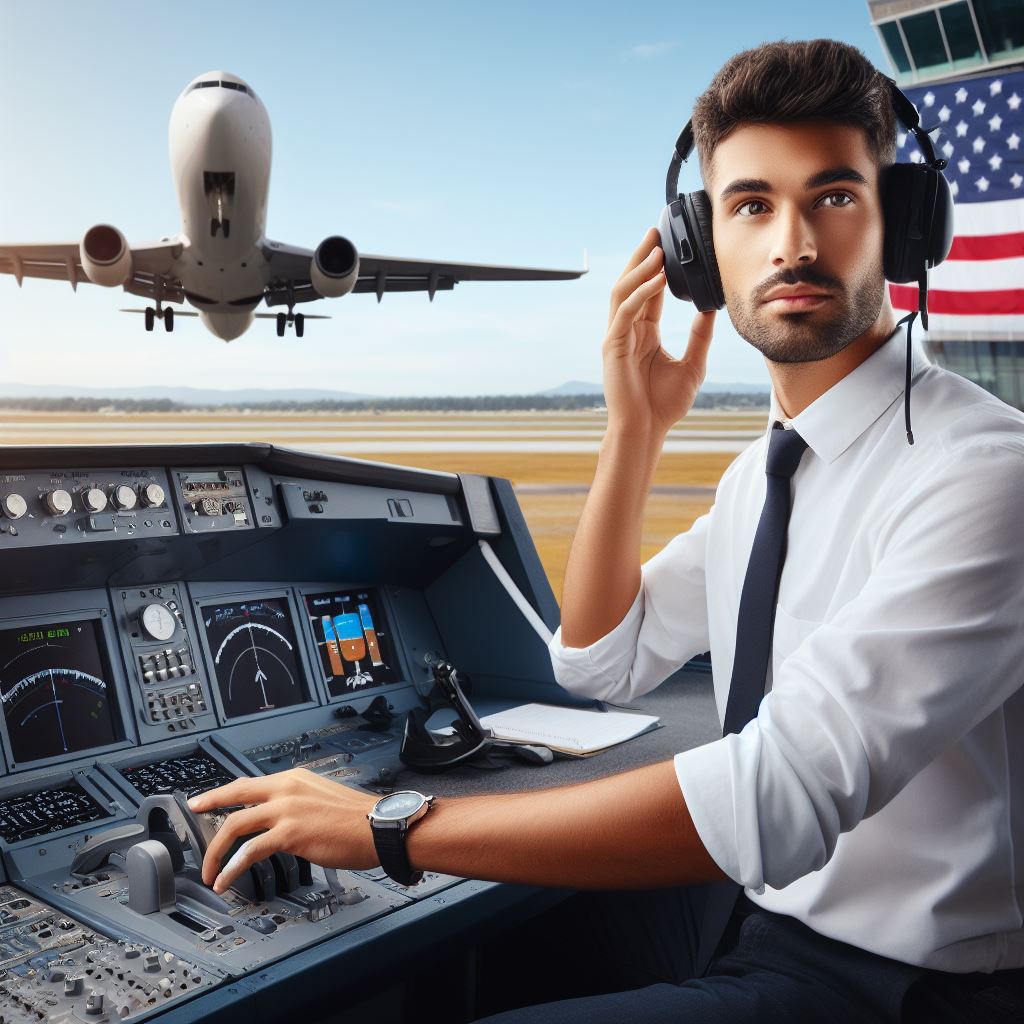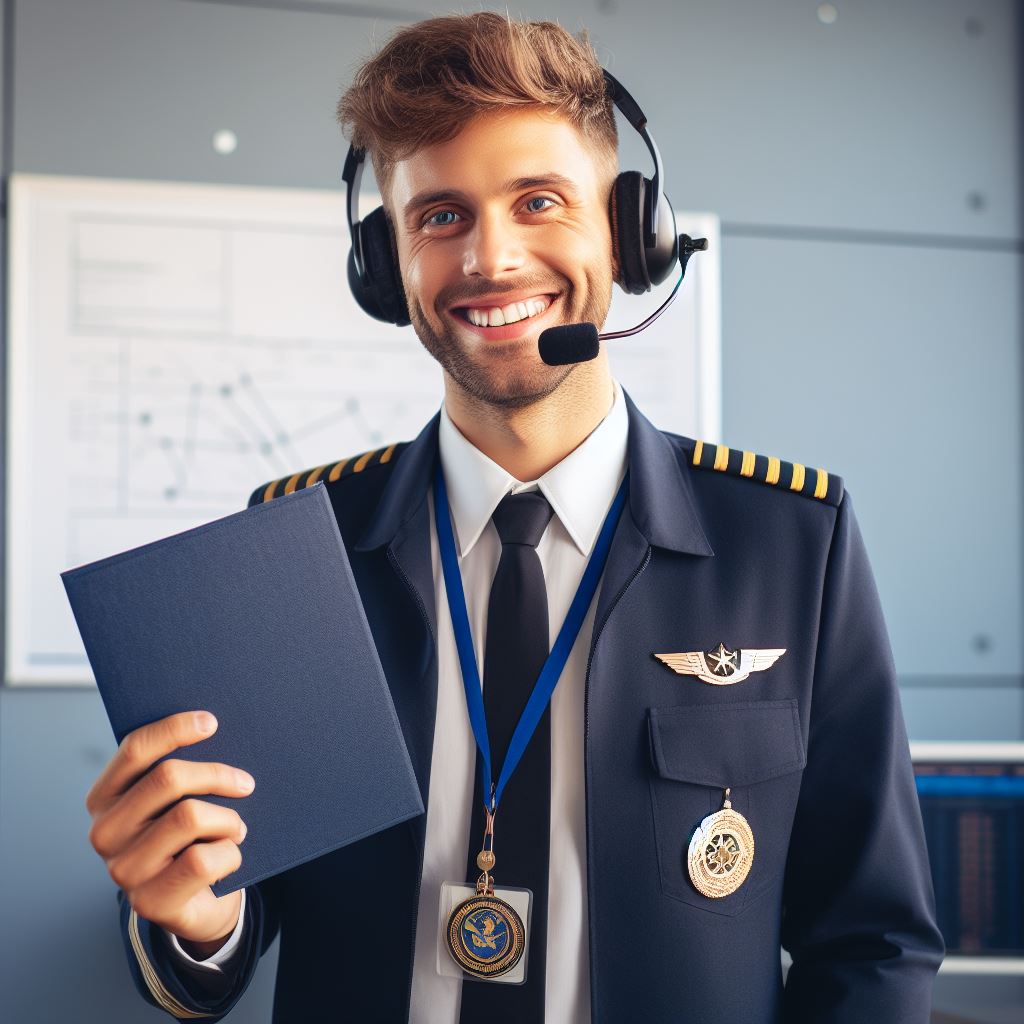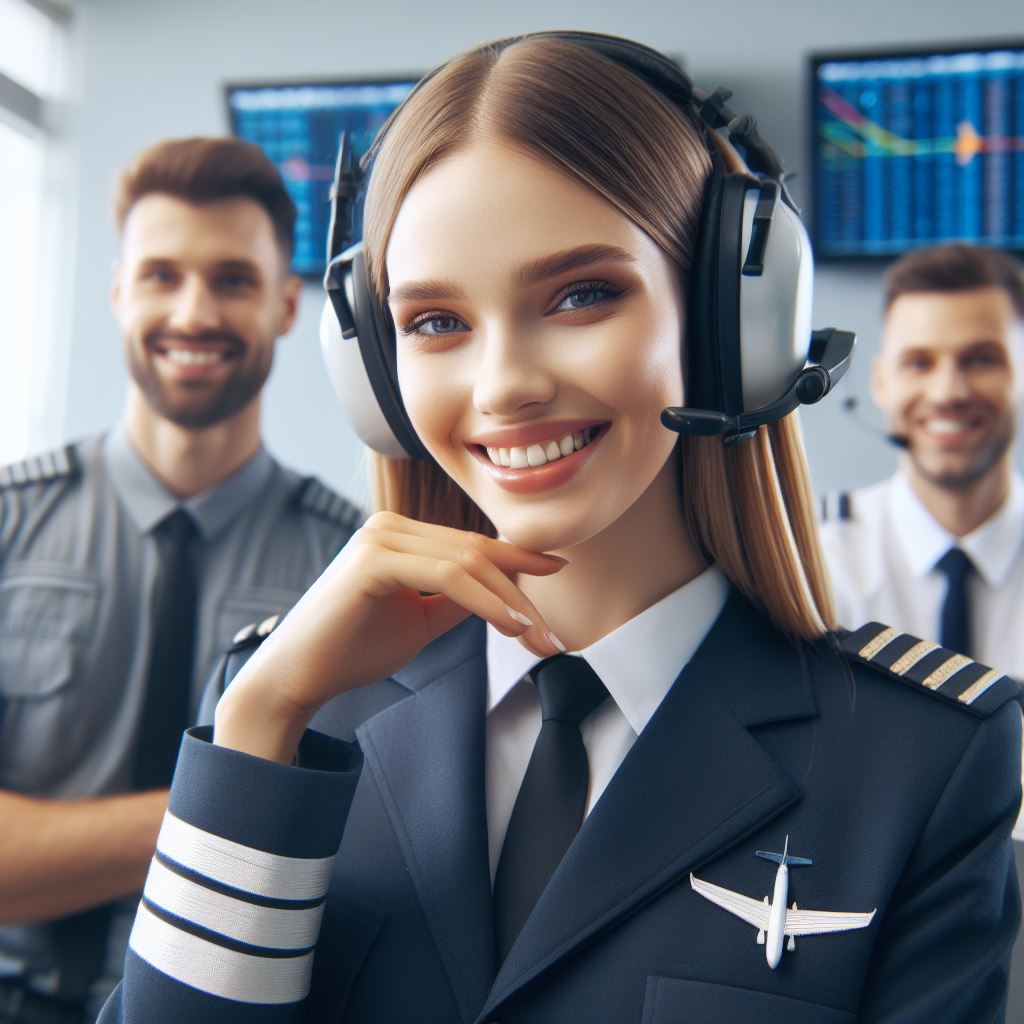Introduction
Air traffic controllers play a crucial role in the safe and efficient operation of the aviation industry.The Air Traffic Controllers Role and Responsibilities are very important.
This blog post aims to provide a brief explanation of their responsibilities, highlight the importance of air traffic control, and outline the purpose of this blog chapter.
Air traffic controllers, also known as ATCs, are professionals responsible for managing the flow of air traffic within designated airspace.
They work from control towers, radar facilities, or en route centers to ensure the safety and orderliness of aircraft movements.
In the aviation industry, air traffic control is vital as it helps prevent mid-air collisions and ensures the smooth operation of flights.
ATCs monitor aircraft movements, provide pilots with guidance and instructions, and coordinate takeoffs and landings.
They also play a critical role in managing air traffic during emergencies or adverse weather conditions.
The purpose of this blog post is to shed light on the responsibilities and challenges faced by U.S. air traffic controllers.
It aims to highlight the crucial role they play in maintaining the safety and efficiency of air travel.
Additionally, it will provide insights into the training and qualifications required to become an air traffic controller, as well as the impact of emerging technologies on the field.
In the following sections, we will delve deeper into the day-to-day responsibilities of air traffic controllers and explore the skills and qualities necessary for this demanding profession.
We will also discuss the training process and certification requirements for becoming an air traffic controller in the United States.
Stay tuned to gain a comprehensive understanding of the role and responsibilities of these unsung heroes of the aviation industry.
Overview of U.S. Air Traffic Controller’s Role
Air traffic control (ATC) plays a crucial role in ensuring the safety and efficiency of air travel.
These highly trained professionals manage the flow of aircraft in the skies, making split-second decisions and providing crucial instructions to pilots.
In this section, we will provide an overview of the role and responsibilities of U.S. air traffic controllers.
Definition of air traffic control (ATC)
Air traffic control, often referred to as ATC, is a service provided by ground-based controllers to direct aircraft in controlled airspace and on the ground.
Their primary objective is to prevent collisions between aircraft, ensuring safe and efficient air travel.
Key responsibilities of U.S. air traffic controllers
1. Maintaining safe and efficient flow of air traffic
Air traffic controllers are responsible for continuously monitoring radar screens, identifying potential conflicts, and taking appropriate action to maintain safe distances between aircraft.
By coordinating takeoff, landing, and en-route procedures, they ensure the smooth flow of air traffic.
Transform Your Career Today
Unlock a personalized career strategy that drives real results. Get tailored advice and a roadmap designed just for you.
Start Now2. Communicating with pilots and providing instructions
One of the crucial duties of air traffic controllers is to communicate with pilots.
They provide clear and concise instructions regarding altitudes, routes, speed adjustments, and any other necessary information to ensure safe aircraft separation.
3. Monitoring weather conditions and adjusting flight plans
Air traffic controllers keep a close eye on weather conditions, such as storms, heavy precipitation, or fog, that can impact flight safety.
They work closely with meteorologists, sharing weather updates with pilots and advising them on necessary flight plan alterations.
Importance of following strict regulations and procedures
Following strict regulations and procedures is paramount in air traffic control.
They provide a standardized framework for controllers to operate within, ensuring consistent practices and minimizing the risk of errors.
By adhering to established procedures, air traffic controllers maintain the highest level of safety for all aircraft under their jurisdiction.
Moreover, air traffic controllers must possess exceptional situational awareness and decision-making skills.
They are trained to analyze complex situations quickly and make critical judgments to ensure the safety of hundreds of lives in the air.
Their ability to remain calm under pressure and effectively handle emergencies is a fundamental aspect of their role.
Generally, air traffic control is a vital service that enables safe and efficient air travel.
U.S. air traffic controllers play a significant role in this system, responsible for maintaining the flow of air traffic, communicating with pilots, and ensuring adherence to strict regulations and procedures.
Their diligent work behind the scenes ensures the safety of millions of people who travel through the skies each day.
Training and Qualifications
When it comes to becoming an air traffic controller in the United States, proper training and qualifications are essential.
A career in air traffic control requires individuals to possess a specific skill set and knowledge base that can only be acquired through rigorous training programs.
In this section, we will explore the various aspects of the training and qualifications necessary to become a U.S. air traffic controller.
Educational requirements
To begin with, individuals interested in pursuing a career as an air traffic controller must meet specific educational requirements.
The minimum educational requirement is a high school diploma or its equivalent.
However, some individuals choose to enhance their qualifications by obtaining an associates or bachelor’s degree in an aviation-related field.
Showcase Your Business Today
Reach thousands of readers actively exploring professional services. Publish your business profile and grow your audience now.
Publish NowWhile not mandatory, a degree can provide a deeper understanding of aviation principles and increase job prospects in a highly competitive field.
Air Traffic Collegiate Training Initiative (AT-CTI) program
The Air Traffic Collegiate Training Initiative (AT-CTI) program is an important pathway for individuals interested in air traffic control.
This program is offered by the Federal Aviation Administration (FAA) and various accredited colleges and universities across the country.
The AT-CTI program aims to provide aspiring air traffic controllers with a solid educational foundation through specialized coursework.
Students in the program can expect to learn about aviation regulations, air traffic control procedures, and safety protocols.
Federal Aviation Administration (FAA) Academy training
Upon successfully completing the educational requirements, aspiring air traffic controllers must undergo training at the FAA Academy.
This training is comprehensive and covers all aspects of air traffic control.
The FAA Academy training consists of three key components: classroom instruction, simulation exercises, and on-the-job training at control facilities.
During the classroom instruction phase, trainees learn fundamental concepts, such as radar operation, communications protocols, and airspace management.
They also study aviation regulations and procedures to ensure compliance with safety standards.
Simulation exercises play a crucial role in the training process.
Trainees are exposed to simulated scenarios that mimic real-life air traffic control situations.
This hands-on experience allows them to apply their knowledge and develop critical decision-making skills in a controlled environment.
After completing the classroom and simulation portions of the training, trainees move on to on-the-job training at control facilities.
This phase provides practical experience under the guidance of experienced air traffic controllers.
Trainees work alongside mentors to practice real-time air traffic control operations, monitor radar screens, and communicate with pilots.
Essentially, the training and qualifications required to become a U.S. air traffic controller involve meeting educational requirements, participating in the AT-CTI program if desired, and completing comprehensive training at the FAA Academy.
These rigorous programs ensure that air traffic controllers possess the necessary knowledge, skills, and experience to safely manage and direct air traffic in the United States.
Skills and Competencies
Air traffic controllers play a critical role in ensuring the safety and efficiency of air travel.
To perform their duties effectively, they need to possess specific skills and competencies. In this chapter, we will discuss the skills required for successful air traffic control.
Strong decision-making abilities
Air traffic controllers must have strong decision-making abilities.
They encounter unpredictable situations regularly, such as sudden weather changes or emergencies.
These professionals need to assess the situation, evaluate possible options, and make decisions promptly to ensure safe aircraft operations.
Excellent communication and listening skills
Effective communication is vital in air traffic control.
Controllers must communicate instructions clearly and concisely to pilots, ensuring they understand and follow them accurately.
Similarly, they must listen attentively to pilots’ responses and acknowledge their understanding or request clarification when needed.
Ability to work well under pressure
Air traffic controllers work in a fast-paced and high-stress environment.
They need to remain calm and composed under pressure, even during critical situations.
Maintaining focus and making the right decisions swiftly is crucial to preventing accidents and ensuring the smooth flow of air traffic.
Multitasking and prioritization skills
Air traffic controllers handle multiple tasks simultaneously.
They monitor multiple aircraft, communicate with pilots, and coordinate with other controllers.
It is essential for them to prioritize tasks effectively, ensuring that critical issues receive immediate attention while also managing routine duties efficiently.
Proficiency in using air traffic control equipment and software systems
Air traffic controllers must be proficient in operating air traffic control equipment and software systems.
These tools help them monitor aircraft movements, communicate with pilots, and manage airspace effectively.
Controllers should stay updated with the latest advancements in technology and demonstrate competence in utilizing these systems.
In fact, air traffic controllers need to possess a range of skills and competencies to fulfill their role effectively.
Strong decision-making abilities, excellent communication and listening skills, the ability to work well under pressure, multitasking and prioritization skills.
As well as proficiency in using air traffic control equipment and software systems are all essential for successful air traffic control operations.
Read: Veteran Pilots Share Their Most Memorable Flights
Work Environment and Shifts
Description of control towers and en-route centers
Working in air traffic control environments such as control towers and en-route centers is a challenging and demanding job.
Showcase Your Business Today
Reach thousands of readers actively exploring professional services. Publish your business profile and grow your audience now.
Publish NowThe role of these facilities is vital in ensuring the safety and smooth flow of air traffic. Let’s take a closer look at the work environment and shifts within this field.
Control towers, as the name suggests, are physical structures located at airports.
They serve as pivotal nerve centers, overseeing the movements of aircraft within a specific airspace.
Air traffic controllers stationed in control towers communicate with pilots and guide them during takeoffs, landings, and taxiing on the ground.
These controllers monitor and maintain safe separation between aircraft to prevent accidents or collisions.
In contrast, en-route centers are responsible for managing aircraft during their flights between airports.
These centers handle a larger airspace and facilitate smooth transitions of aircraft from one control area to another.
Controllers in these centers communicate with pilots in a similar manner as those in control towers, ensuring safe and efficient passage for the aircraft.
Round-the-clock nature of air traffic control
One of the essential characteristics of the air traffic control profession is its round-the-clock nature.
Air traffic control operations run continuously, 24 hours a day, seven days a week.
This ensures that aircraft are constantly monitored and guided, regardless of the time or day.
The relentless dedication of air traffic controllers helps maintain the integrity and safety of the national airspace system.
Shift work and irregular schedules
Due to the nature of this job, air traffic controllers often work in shifts that encompass evenings, weekends, and holidays.
These rotational shifts can lead to irregular schedules, disrupting the personal lives of controllers.
The unpredictable nature of air traffic also means that controllers must be prepared to adapt to changing work hours and demands.
Stressful nature of the job and coping mechanisms
The job of an air traffic controller is undeniably stressful.
The responsibility of managing aircraft and ensuring the safety of passengers and crew puts immense pressure on these professionals.
They must make split-second decisions while staying calm and focused. The ever-present stress can take a toll on the mental and physical well-being of controllers.
To cope with the demanding nature of their job, air traffic controllers employ various mechanisms.
Engaging in regular exercise helps reduce stress levels and maintain overall well-being.
Meditation and relaxation techniques are also effective coping strategies.
Additionally, establishing a supportive work environment and fostering good relationships with colleagues can help alleviate stress.
In general, the work environment of U.S. air traffic controllers is intense and challenging.
They operate in control towers and en-route centers to oversee the safety and efficiency of air travel. With their crucial round-the-clock operations, controllers work in shifts and face irregular schedules.
However, despite the stressful nature of the job, they employ coping mechanisms to maintain their well-being and continue providing exceptional service.
Read: How Technology is Changing the Future of Flying in the US

Safety and Emergency Situations
Role in responding to emergencies and air traffic incidents
Air traffic controllers play a crucial role in responding to emergencies and air traffic incidents.
In times of crisis, these professionals are the ones who remain calm and take charge of the situation.
- They coordinate with pilots to provide appropriate instructions and guidance during emergencies, such as engine failures or medical emergencies onboard.
- Air traffic controllers communicate with emergency services, such as fire and rescue teams, to ensure a swift response to any incident that may occur within the airport vicinity.
- They are responsible for directing aircraft away from any potential danger or hazard, while also maintaining efficient traffic flow.
Collaborating with other stakeholders in emergency situations
During emergency situations, air traffic controllers collaborate with various stakeholders to ensure a coordinated response.
- They coordinate with airport authorities, security personnel, and law enforcement agencies to ensure the safety and security of passengers and personnel within the airport.
- Air traffic controllers work closely with maintenance technicians to quickly assess and address any technical issues that may arise during emergencies.
- They collaborate with airline representatives to gather necessary information and provide updates to passengers and their families during critical situations.
Ensuring the safety of aircraft during adverse weather conditions
One of the crucial responsibilities of air traffic controllers is to ensure the safety of aircraft during adverse weather conditions.
- They closely monitor weather forecasts and reports to anticipate potential weather-related risks and take necessary precautions.
- Air traffic controllers provide guidance to pilots, instructing them to deviate from their planned routes or adjust altitudes to avoid severe weather systems.
- They coordinate with meteorological services to gather real-time weather information and disseminate it to pilots in a timely manner.
Responding to equipment failures and system malfunctions
Air traffic controllers are trained to respond promptly and effectively when faced with equipment failures and system malfunctions.
- They troubleshoot and identify the cause of equipment failures, such as radar or communication systems, to minimize disruptions in air traffic operations.
- Air traffic controllers coordinate with maintenance technicians to promptly resolve equipment failures and restore normal operations.
- They implement contingency plans and reconfigure air traffic separation standards to ensure uninterrupted flow of aircraft during system malfunctions.
In fact, air traffic controllers have significant roles in ensuring safety during emergencies, collaborating with stakeholders, managing adverse weather conditions, and responding to equipment failures.
Their expertise and ability to make split-second decisions contribute greatly to the overall safety and efficiency of air traffic management systems.
Read: A Day in the Life of a US-based Airline Pilot
Discover More: Emerging Trends: The Future of Logistics in America
Challenges Faced by Air Traffic Controllers
Heavy workload and high levels of stress
Air traffic controllers have to handle a significant workload, managing multiple aircraft simultaneously.
They must process and analyze a vast amount of information in real-time, which can be mentally exhausting.
The pressure to make split-second decisions accurately adds to the stress levels they experience daily.
Additionally, controllers often work long hours, including nights, weekends, and holidays, contributing to the strain.
Managing conflicts and resolving issues with pilots
Air traffic controllers frequently encounter challenging situations that require effective conflict management skills.
Showcase Your Business Today
Reach thousands of readers actively exploring professional services. Publish your business profile and grow your audience now.
Publish NowThey must maintain communication with pilots, providing them with instructions and guidance throughout their flights.
In cases of miscommunication or disagreement, controllers need to handle conflicts calmly and find swift resolutions.
This involves remaining professional, maintaining composure, and ensuring the safety of all aircraft involved.
Complex and changing regulations
Air traffic controllers need to stay up-to-date on a wide range of aviation regulations, which are constantly evolving.
These regulations dictate the procedures and protocols that controllers must adhere to while managing air traffic.
Controllers must interpret and implement these complex rules accurately, ensuring compliance at all times.
Moreover, they must adapt swiftly to any regulatory changes, which can be a challenging aspect of their responsibilities.
Technological advancements and adaptation to new systems
The field of air traffic control is heavily influenced by technological advancements.
Controllers must continuously learn and adapt to new systems and technologies used in their work.
They require comprehensive training to efficiently use radar systems, computer programs, and digital communication systems.
Effectively utilizing this technology is vital for maintaining safe and efficient air traffic operations.
However, the rapid rate of technological advancements poses a constant challenge to controllers.
They must keep pace with the latest developments and rapidly learn how to use new tools effectively.
In general, air traffic controllers face numerous challenges in their roles and responsibilities.
Dealing with heavy workloads, managing conflicts, understanding complex regulations, and adapting to technological advancements are all part of their daily job.
Despite the difficulties, air traffic controllers play a crucial role in ensuring the safety and efficiency of air travel.
Their dedication and ability to handle these challenges contribute significantly to the smooth functioning of the aviation industry.
Read: Behind the Scenes: The Role of Dispatchers in Trucking
Conclusion
Air traffic controllers ensure safe and efficient aircraft movement, managing takeoffs, landings, and en-route traffic.
They communicate critical instructions, prioritizing safety and preventing collisions. Continuous monitoring and rapid decision-making are essential, as controllers guide aircraft through varied weather conditions and unexpected situations.
Collaborating with pilots and fellow controllers, they maintain precise coordination for seamless air traffic flow.
The role demands excellent communication skills, quick reflexes, and a thorough understanding of aviation regulations.
Their contribution cannot be overlooked or underestimated.
Professionals in aviation safety play a pivotal role, ensuring the security of air travel globally.
Their diligence safeguards lives, earning them recognition for their indispensable contributions to the industry.
The commitment of these experts to upholding safety standards is paramount, instilling confidence in passengers and maintaining the integrity of the aviation system.
Their continuous efforts and expertise in risk assessment and mitigation contribute significantly to the prevention of accidents and incidents.
As unsung heroes, they navigate complex challenges, constantly adapting to new technologies and evolving threats, exemplifying dedication to the highest safety standards in aviation.
Their vigilant work underscores the collaborative commitment to making air travel not just efficient but, above all, safe.
Acknowledging their vital role is essential in appreciating the seamless functioning of the global aviation network.
The demanding nature of the job highlights the need for skilled professionals in this field.
Flying careers demand precision and expertise. Skilled professionals navigate challenges, ensuring safety and efficiency in complex aviation environments.
The industry’s demanding nature necessitates continuous training and dedication. As aviation evolves, proficient individuals play a pivotal role in meeting industry demands.
The need for skilled professionals underscores the critical importance of ongoing education and specialized training.
Meeting the demands of this dynamic field requires a commitment to excellence and a constant pursuit of mastery.
In this challenging environment, the significance of skilled aviation professionals cannot be overstated, emphasizing the industry’s reliance on their competence and dedication.
[E-Books for Sale]
The Big Book of 500 High-Paying Jobs in America: Unlock Your Earning Potential
$19.99 • 500 High-Paying Jobs • 330 pages
Explore 500 high-paying jobs in America and learn how to boost your career, earn more, and achieve success!
See All 500 High-Paying Jobs of this E-Book
1001 Professions Without a Degree: High-Paying American Jobs You Can Start Now
$19.99 • 1001 Professions Without a Degree • 174 pages
Discover 1001 high-paying jobs without a degree! Unlock career tips, skills, and success strategies for just $19.99!




